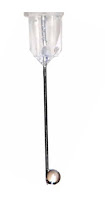Read all posts from November 2015

Using pomelo peel for the synthesis of monolithic ordered mesoporous silica Monolithic ordered mesoporous silicas are highly attractive as sorbents in extraction techniques due to their physicochemical characteristics. To be really effective, there must be a balance between their macroporous and mesoporous structure. Macropores enhance the extraction kinetics allowing an easier diffusion of the target compounds from the bulk samples to the active surface of the material. Mesoporous defines the active surface of the material.... Link to the post Dynamic electromembrane extraction The potential of electromembrane extraction (EME) is beyond any doubt [1]. As you well know, it is based on the electromigration of the target charged analyte from the donor phase (the sample) to the aqueous acceptor phase through a polymeric membrane that physically separates both phases. The extraction is rapid and it provides high enrichment factors...... Link to the post Bubble-in- drop single

